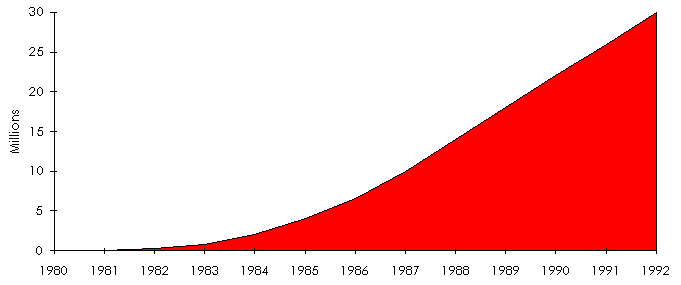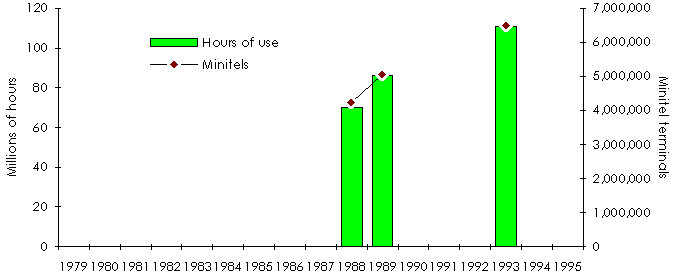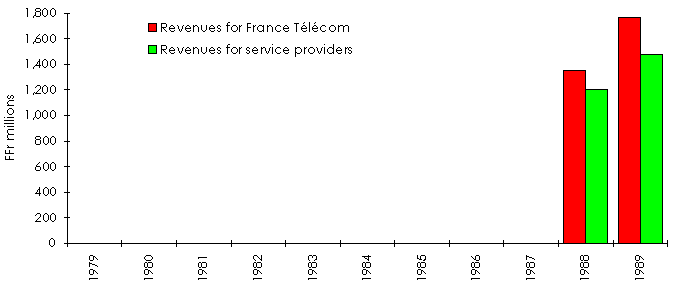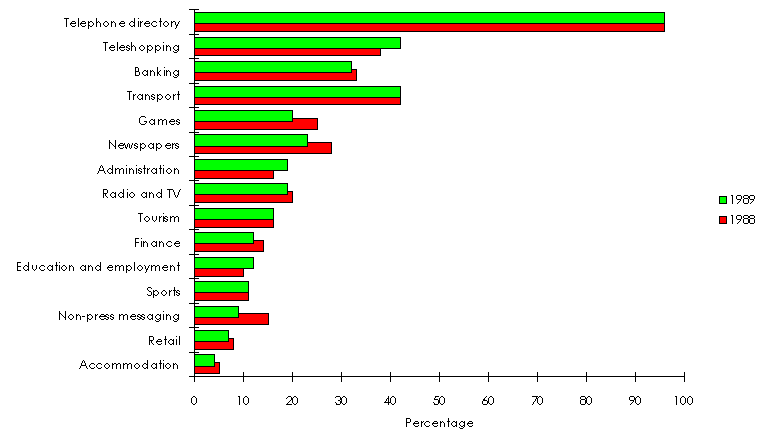
Source: France Télécom
Whether as the DGT or as France Télécom, the French PTT was breaking new ground in moving into videotex. The DGT knew little about broadcasting or about collaboration with information providers and almost nothing about consumers. What it did have was the ambition and the desire to emulate other great technological feats, such as Concorde and the Train à Grande Vitesse (TGV).
The French government and PTT chose to develop videotex primarily because of its hightech image combined with the potential of the service to reach such a large part of the population. Videotex promised to help overcome the image of France as being backward in telecommunications. Moreover, it would support the growth of the public data network, Transpac. Undaunted by the failure of Prestel in the domestic market, the French chose to target that market.
The objective of conquering the world market has not been achieved. In spite of some successes, the computing and telecommunications industries are far from being able to rely on French electronics suppliers. Few peripheral devices have been developed or sold and many components of the Minitel terminal have had to be imported. [Salomon, 1986]
An electronic telephone directory service was also being developed. Initially it was tested separately in 1983 in St Malo, then expanded to the departement of IlleetVilaine in Brittany. Brittany has been a common testing ground for French telecommunications.
An important decision was not to follow the British route of using television adaptors, but to choose a dedicated terminal, the Minitel. France Télécom also chose to focus on the residential market, rejecting the failure of Prestel, in the belief that they could push through to success. Technologically, the system was second generation videotex.
The T3V experiment led to a fullscale plan for the introduction of Minitels into the rest of France. The aim was to provide free terminals to all telephone subscribers. It was to be paid for by the substitution of the existing paper telephone directories with access to a database containing details of all French telephone subscribers. Thus exchanging a local paperbased and, inevitably, out-of-date service for a national uptodate and online service. To keep down unit costs, the scale of purchases was to be very large, aiming at 500 francs per terminal.
The scope of the initial plan was breathtaking aiming at over 20 million Minitels by 1990. This was intended to solve the historical problems of slow uptake of communications in France.

Source: France Télécom
However, after the election of President Mitterrand and the Socialist Party in 1981 the compulsory replacement of the printed directory was abandoned for political reasons; compulsion was felt to be excessive. Thereafter, only volunteers were given Minitels, causing a major loss in momentum to the plan. Nonetheless, over 5,000,000 Minitels have been distributed and over 5,000,000 hours of connect time are used each month.

Source: France Telecom

Source: France Telecom
It was only a small minority who used more than four services (see Figure 1). There are a small proportion of heavy users, amongst whom are an even smaller minority of addicts who generate enormous bills. Given the nature of the services they use, they will be quite different from, for example, the schizoid addicted programmers described by Shotton [1990].

Source: Arnal et Jouet, 1989

Source: Arnal et Jouet, 1989

Source: France Télécom, 1989.
If one is to identify a single feature which encouraged the creation of new services on Minitel it was the kiosk tariffs. This allowed potential new service providers to startup without an established market. The kiosk tariff system operated by France Télécom collects a charge from the telephone subscriber for the services used, based on a call to one of a number of special telephone numbers; France Télécom separately records the number of connect minutes to each service. The tariff system is now highly sophisticated, allowing a variety of divisions in cost between users and providers, ranging from free to nine francs per minute.
Thus the service provider does not need a complicated accounting system, nor does it require prepayment. In effect, France Télécom acts as an intermediary between customer and supplier. Behind the kiosk tariffs is the distance independent tariff of Transpac, making the location of the computer providing the service irrelevant.
The real success of the kiosk system lay in allowing service providers on Minitel to differentiate themselves. A subscriber dials 36.15 then keys in the brand name of a product or service:
For example, 36.15 Coke is aimed at promoting the image and products of CocaCola through the provision of games and news concerning sport and music, it also offers a reservation system for concert tickets. Thus it is easy to associate a Minitel service with existing or new products and services.
In other countries, the necessity of prepayment or the use of credit cards has presented considerable obstacle to the use of videotex services. Similarly, paying by page was found to be a discouragement, it seemed to be an 'unnatural' way to charge, it is better to charge by time. Adverts appear to be treated by consumers as intrusive.
Messagerie Conviviale & Messagerie Rose
Minitel has been seen as the birth of a new cultural industry sitting beside film, radio and television. It is claimed to be different because the network is used for broadcasting, communication and transactions. It does not appear to fit with traditional models of editing used for the written or spoken word, neither are the approaches of film or television appropriate. Through the messaging services, the public can communicate with each other; often concealed by a pseudonym. [Pajon, 1989]
Whilst there may be some merit in the argument that Minitel is a new medium, it cannot be held to be true. Minitel is similar to too many other services for the distinction to be valid. The messagerie services are similar to conventional electronic mail and bulletin boards. The game services are closely related to the thriving market in computer games. Home banking and teleshopping are extensions of information systems which are otherwise unremarkable and closely linked to EPoS and EFTPoS. The telephone directory is simple information retrieval.
Minitel is unique in scale, scope and the degree of integration, but it is not unique in function.
A wide range of business services can be found on Minitel. These include links to clients, suppliers and within firms providing new levels of connectivity within and between organisations.
The applications in the business sector reflect similar applications to those found elsewhere in the world. Where the French applications are different lies in the low cost entry into telecommunicationsbased services. Thus the French firm Drogerie Bordelaise did not have to face the same costs as the American firm Baxter Healthcare to establish telecommunications links with their customers [Monnoyer and Philipe, 1989]. The French company was able to adopt a standard terminal, the Minitel, which the client might already possess or could obtain very cheaply. There was no need to lease lines, to develop access methods to the public switched data networks or to acquire telecommunications management skills. Minitel was already there providing these services.
The Minitel infrastructure significantly lowered entry barriers into telecommunicationbased services representing a form of subsidy from France Télécom (effectively the taxpayer) to businesses. The Minitel network can be seen as pumppriming investment by France Télécom to generate network revenues on a system with high fixed costs. The validity of this depends on the government making a return on the investment or obtaining some other national goal.
http://www.goergetown.edu/sutherland/minitel/developing.html